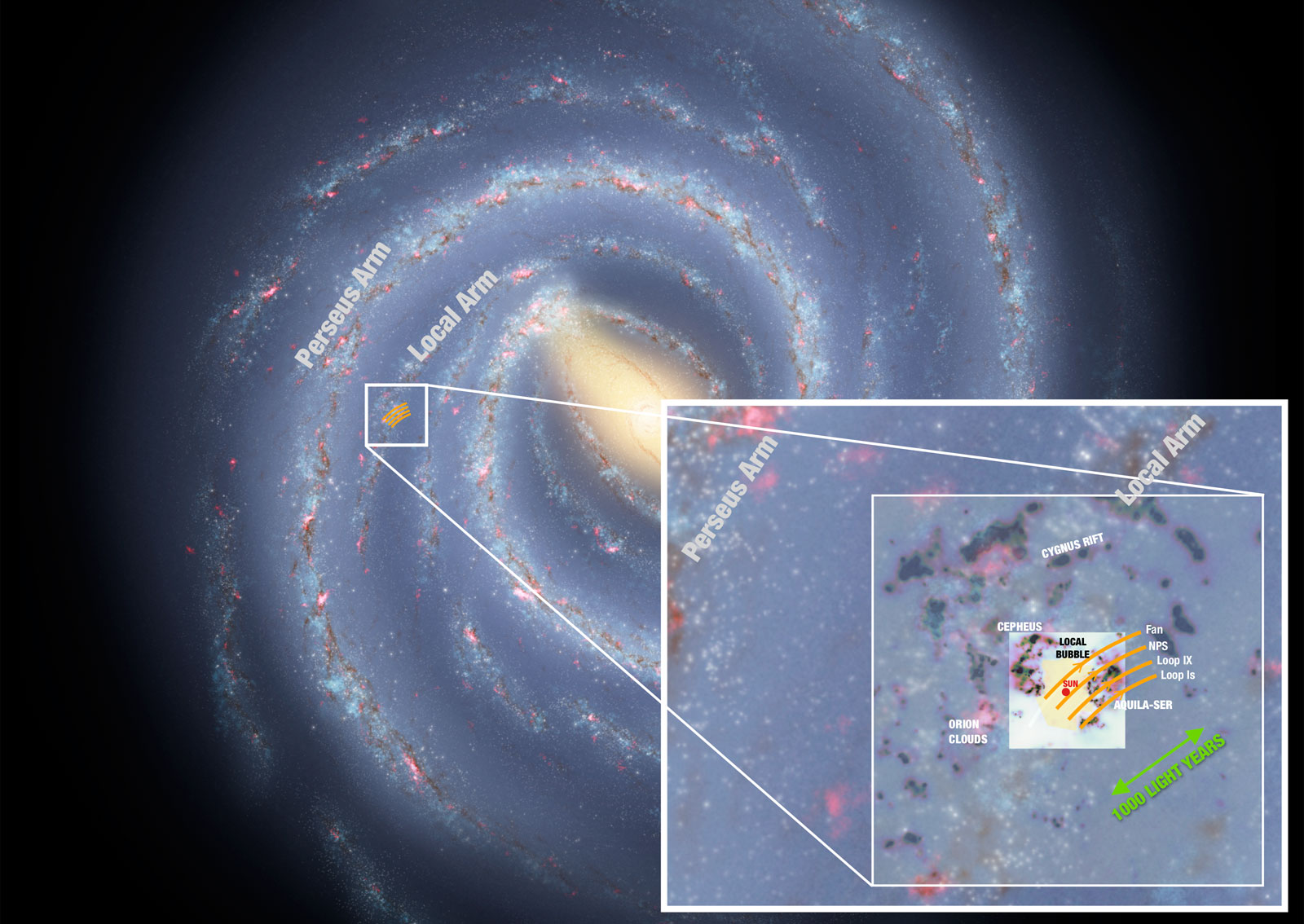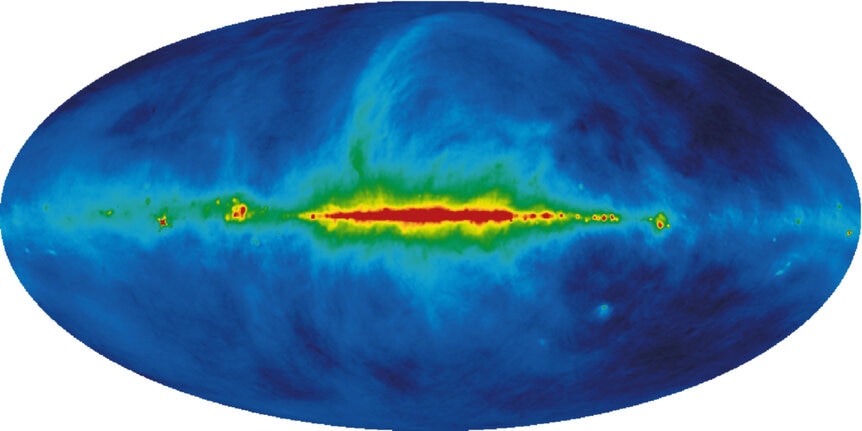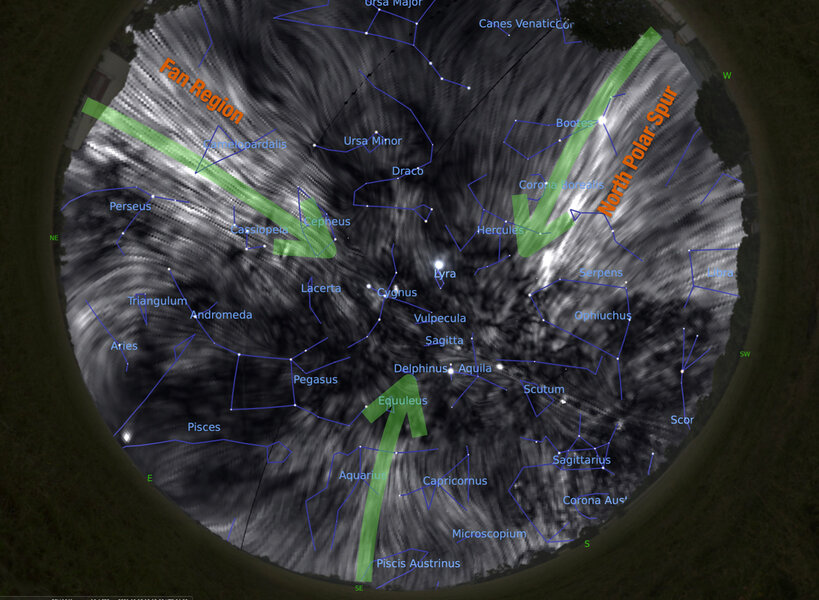Create a free profile to get unlimited access to exclusive videos, sweepstakes, and more!
Huge structures in our galaxy may show the Sun is in a kind of cosmic magnetic tunnel
It's not conclusive, but giant radio wave features splayed across the sky may be connected.

New work by a team of radio astronomers provides convincing evidence that the Sun is sitting in a gigantic tunnel-like structure in the galaxy surrounded by huge, elongated magnetic filaments that are so big and so close to us that we see them splayed out across the entire sky.
When we see something in the sky, many times it's hard to know how far away it is. Is it small and close, or huge and far away? For a lot of objects we have ways of measuring their distances, but for others it's much more difficult.
And that's why some structures seen in the sky have been difficult to understand. When we map the whole sky with radio telescopes, which "see" light with much lower energy and longer wavelengths than what our eyes see, the galaxy around us lights up. Because the Milky Way is a flat disk and we are in that disk, we see it as a broad swath across the sky; if we use the right kind of map projection — called a Mollweide projection, commonly used for maps of the Earth — we see that as a thick line right through the galactic equator.
This was done decades ago, in the 1950s, and right away a long, curved filament stretching up and away from the galactic disk near the center was seen. This is called the North Polar Spur, since it goes up to near the galactic pole. Other filaments can be seen below it as well.
Not long after more diffuse emission was seen, not quite as sharply defined as the North Polar Spur (or NPS) and fainter, stretching up from the galactic plane (from the left edge of the map to about halfway to the center, and on the extreme right edge as well), called the Fan Region.
Astronomers have argued about the nature of these two structures. The NPS seems to come from near the galactic center, so many argue that it's located physically in the middle of our galaxy, 26,000 light years away. It's also loosely aligned with huge X-ray bubbles centered in the middle of the galaxy, implying they're connected. But most of the methods used to infer its distance can't really distinguish between it being a thousand light years away and more than ten thousand. It might be near the galactic center, but it might also be a local feature of the spiral arm the Sun is currently in.
Same with the Fan Region. But in this case the argument that it's closer to us is stronger. Some radio observations are sensitive to polarized light, which is when the electromagnetic waves of incoming light are aligned in a certain way. The radio waves from both the NPS and Fan are polarized, and moreover stars we see toward the direction of the Fan Region also show some polarization in their light that aligns the same way. Those stars are relatively close to the Sun; that implies the Fan Region is close to us too and polarizing the starlight.
What the astronomers in the new work posit is that these two features, and several others like them, are all part of a much larger structure: A partially hollowed-out gently curving tunnel in the galactic gas inside our local spiral arm, and along the walls of that tunnel are parallel filaments of magnetized material. The Sun sits near one side of this tunnel, and the shape we see for them in the sky is determined by their physical shape and perspective.
Imagine a highway tunnel cut through a mountain, for example. It's a long, perhaps curving cylinder. Now imagine someone paints stripes down the middle of the road as well as halfway up the sides and then one along the very top of the tunnel. If you drive on the right side of the road you'll see one line close to you, and the others over to the left, one down and to the left, one above and to the left, and the other straight out your driver's side window. You'll see them appear to converge ahead and behind you due to perspective.
This is very nearly what we see with these radio filaments; the tunnel analogy does fit the data pretty well.
What could cause this? We know the Sun sits in a blobby volume of space called the Local Bubble. It's very roughly a thousand light years across, elongated, and the density of interstellar gas in it is lower than surrounding regions. We think it was carved by a dozen or more supernovae (exploding stars) in the past 15–20 million years; the expanding debris from these supernovae pushed against the gas around them like a snowplow, excavating the bubble.
We also know that filamentary structures can form in places where bubbles form; we see them commonly in supernova remnants. They're due in part to interactions of the magnetic fields of the expanding stellar debris and the magnetic fields in gas in the galaxy. This would explain the shape and alignment of the tunnel, too. We know magnetic field lines are parallel with the curved arms in spiral galaxies. The filaments appear to roughly follow that same direction of our local arm.
The fact that these filaments are seen in polarized light supports this, too. Dust grains in space tend to align along the magnetic field lines, and light bouncing off them gets polarized (similar to how light reflected off a metal car hood is polarized, and you can reduce the glare using polarized sunglasses). Also, electrons spin around these magnetic field lines like beads on a wire and give off polarized light as well (called synchrotron emission).
So the tunnel model holds together. It's possible then, even likely, that other such partially-hollowed tunnels exist all along the spiral arms of the galaxy.
The model's not perfect, though; while it does explain the shape, polarization structure, and even the brightness of the filaments, some parts of the filaments don't fit the model well. But it's possible there are local disturbances in the magnetic field lines that distort the tunnel and filaments. I'd actually be surprised if there weren't. The galaxy is a messy place, with stars exploding and huge nebulae cranking out stars and black holes blasting out high-energy jets of material, all of which can locally distort the magnetic field.
One thing that really impresses me about all this is how it unifies these features seen all over the sky. It's not at all obvious that something seen to the north in the sky would be connected in any way to something 100 degrees away. And it can be really hard to see literally the big picture; we know of other large structures that occupy a lot of real estate in the sky and it turns out they're big but local, so they're spread out over vast regions above our heads.
I actually rather hope this model turns out to be correct. I love the idea of looking up in the night sky and seeing features so huge and so close that you'd have to turn your entire body to see them... assuming you have radio-sensitive eyes. You don't, but you do have an imagination, and nothing spurs mine more than knowing I am inside a series of enormous structures, from billions to tens of thousands of trillions of kilometers long, one nested inside the other, all the way out to the entire Milky Way Galaxy itself.
We exist inside a series of cosmic matryoshka dolls, with other dolls nested alongside with us, and when we stand on Earth and look out we see out through them to the Universe beyond. That's a phenomenal and lovely thing to imagine.





























